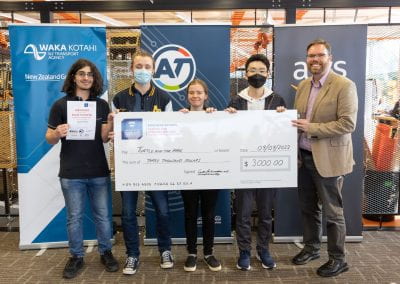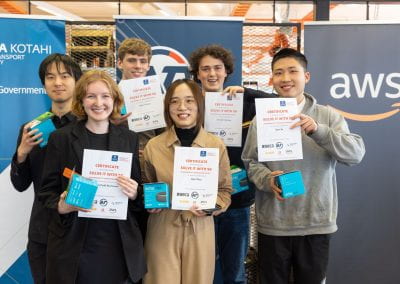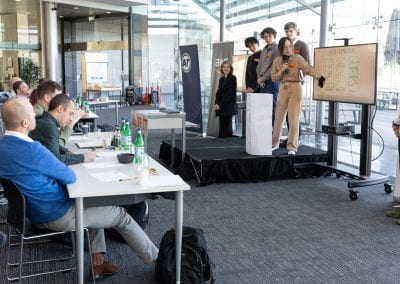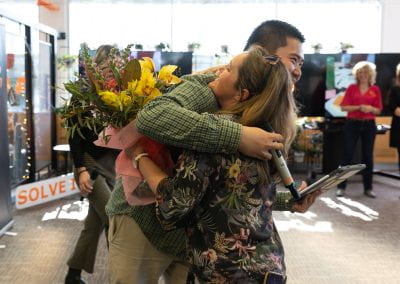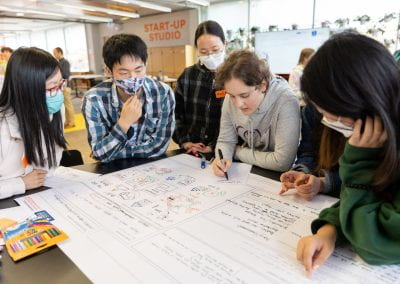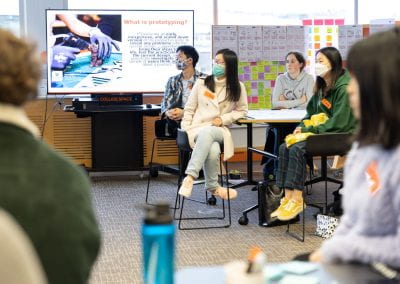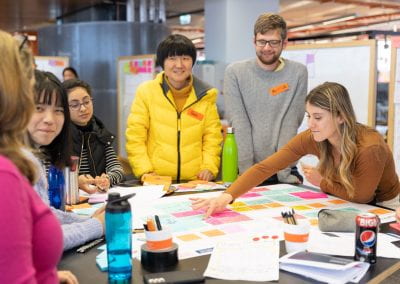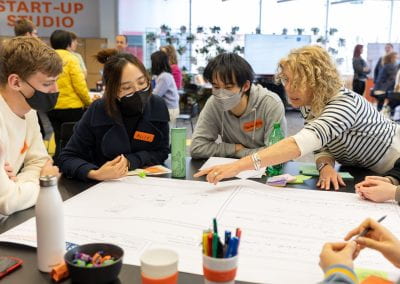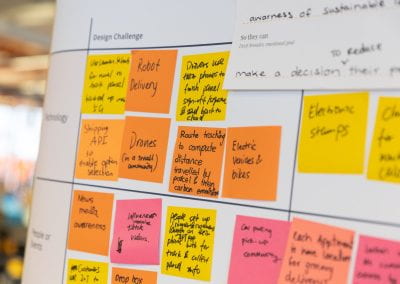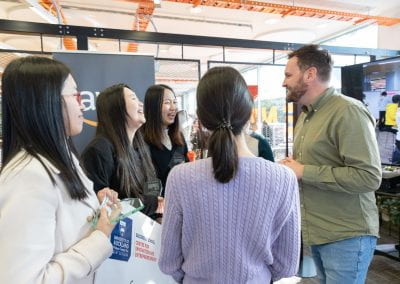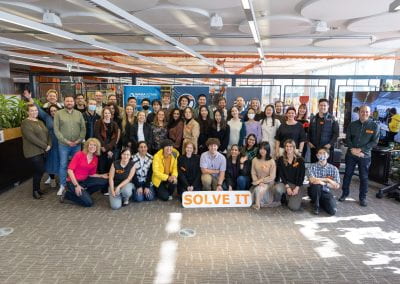
NEWSROOM
Students rise to the challenge of solving sustainability problems with 5G
21 September 2022
Behaviour change problems of sustainable shopping, sidewalk safety and composting were addressed with hi tech solutions in the first ever Solve It with 5G sustainability innovation sprint run by the University of Auckland Business School’s Centre for Innovation and Entrepreneurship (CIE).
Solve It with 5G was a week-long innovation sprint designed to get participants to think, ideate and create solutions to sustainability problems. Participants developed ideas to use technology to make the world a better place, with opportunities to gain friends, professional contacts and cash prizes.
Solve It with 5G was the first co-curricular programme utilising the University of Auckland Business School’s brand new 5G lab, Te Ahi Hangarau, which was created with support from Vodafone to ignite in students enough of an understanding and proficiency in emerging technologies to be able to ideate new business innovations.
CIE Director Darsel Keane says “Solve It with 5G was open to students of all faculties to apply to participate in. Opportunities for transdisciplinary education are so important as innovation comes from diversity of knowledge and perspectives. In designing Solve It with 5G we ensured that participants had the opportunity to learn about cutting edge technology and skills such as design thinking and conducting empathy interviews, which will serve them well as they enter the working world.”
Thirty students from a range of faculties joined as individuals and were put into teams to solve a sustainability problem posed by Solve It industry partners including Auckland Transport, Waka Kotahi (New Zealand Transport Agency) and engineering firm Beca.
Keane says “Transport is responsible for 17 per cent of Aotearoa New Zealand’s gross emissions and also has human impact factors in terms of safety and loss of productivity. It’s great to see our partners embracing the potential of new technology to solve contemporary problems. They not only supported participants with prizes, they also briefed the students to fully understand the challenges New Zealanders are facing, answered questions and provided well considered feedback in their judging.”
The ultimate winner of Solve It with 5G was Team Connect, who were tasked with exploring how Auckland might redevelop its road network to adapt to climate change, making it more people-centric. The team’s winning solution, formulated over an intensive week of collaboration and innovation, is designed to make footpaths safer by warning people of approaching traffic.
Team member Cissy Xiang, a Global Studies and Arts student, says “5G positioning technologies can provide better location resolution than existing GPS and we looked at how we could use existing Internet of Things (IoT) networks, such as those Auckland Transport and several of the scooter companies use, to provide a service that alerts people to any potential obstacles, especially when they don’t have a clear line of sight.”
As part of the solution-finding process, Team Connect interviewed university students and staff to find out about their experiences on shared paths. “Many said they were worried about being hit by scooters,” says Cissy. “There aren’t many regulations regarding e-scooters in Auckland, and although the different companies can employ speed limits for different areas and all have top speeds, some private e-scooters can go much faster. This is a big issue, and as part of the Solve It with 5G competition, we wanted to find a way to help people feel safer using shared pathways, whether walking, cycling or scootering.”
The runner-up team, Turtle and the Hare, came up with a way to encourage more sustainable shopping. They decided to find a way to help New Zealanders recognise and utilise their buying power so that they might contribute to a more sustainable system.
Law and Global Studies student Samuel Bain says “We focused on supermarkets and using Imagr trolley technology we could track exactly what was put into and taken out of shopping carts. A tablet screen could be installed to provide augmented reality wayfinding and information on sustainable products.” Every sustainable item scanned would earn points in a loyalty system, and if a cart had more than 60 percent sustainable items, says Samuel, the shopper could skip the queues at the checkout and pay on the tablet attached to the trolley.
Third place in the challenge was awarded to team DJ Maas for their plan to increase composting by incentivising it for everyone through gamification and loyalty points.
Winning teams came away with a share of $8,000 cash and other prizes. Members of Team Connect all received a trophy and were invited to meet with Auckland Transport to further discuss their solution.
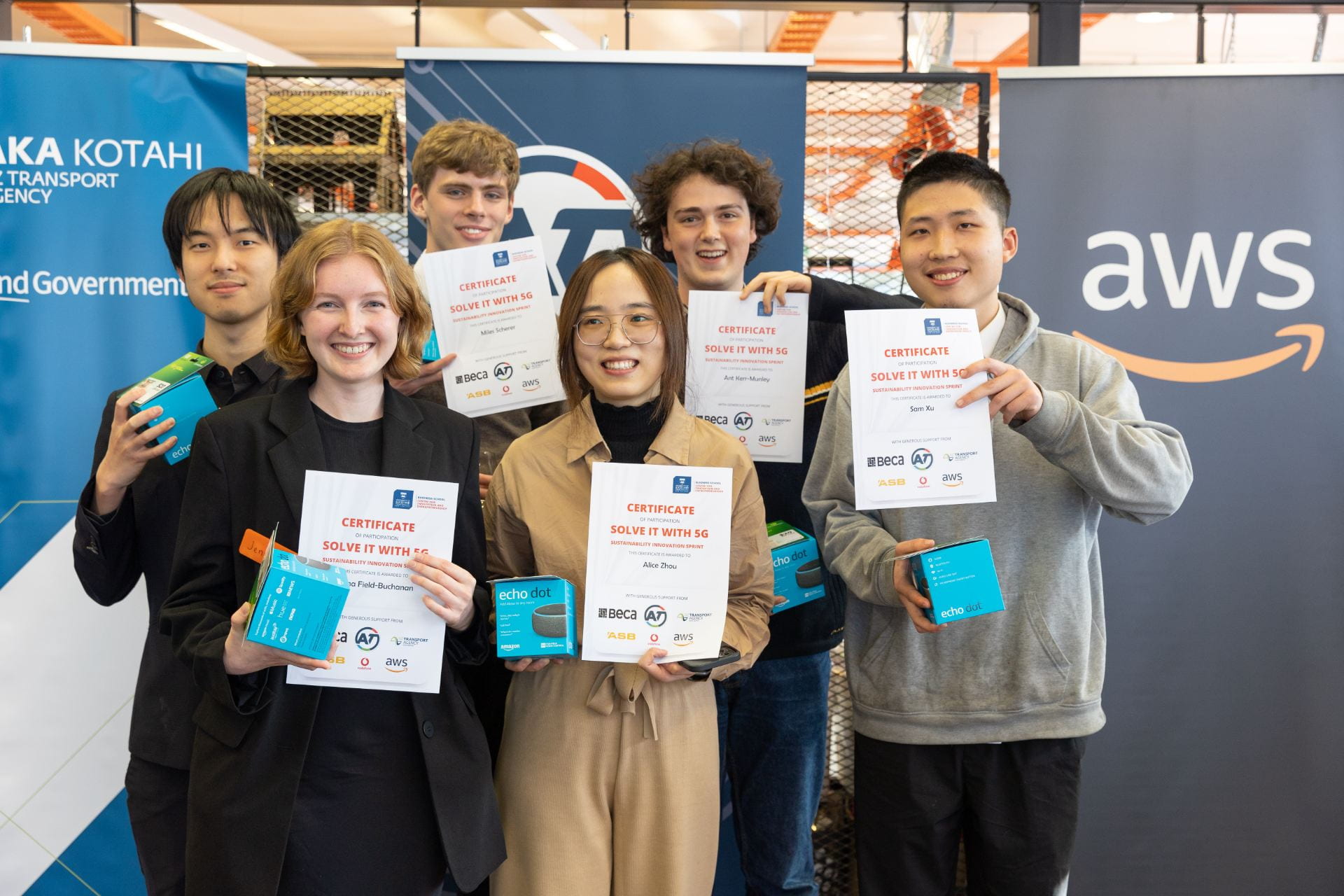

21 September 2022
Behaviour change problems of sustainable shopping, sidewalk safety and composting were addressed with hi tech solutions in the first ever Solve It with 5G sustainability innovation sprint run by the University of Auckland Business School’s Centre for Innovation and Entrepreneurship (CIE).
Solve It with 5G was a week-long innovation sprint designed to get participants to think, ideate and create solutions to sustainability problems. Participants developed ideas to use technology to make the world a better place, with opportunities to gain friends, professional contacts and cash prizes.
Solve It with 5G was the first co-curricular programme utilising the University of Auckland Business School’s brand new 5G lab, Te Ahi Hangarau, which was created with support from Vodafone to ignite in students enough of an understanding and proficiency in emerging technologies to be able to ideate new business innovations.
CIE Director Darsel Keane says “Solve It with 5G was open to students of all faculties to apply to participate in. Opportunities for transdisciplinary education are so important as innovation comes from diversity of knowledge and perspectives. In designing Solve It with 5G we ensured that participants had the opportunity to learn about cutting edge technology and skills such as design thinking and conducting empathy interviews, which will serve them well as they enter the working world.”
Thirty students from a range of faculties joined as individuals and were put into teams to solve a sustainability problem posed by Solve It industry partners including Auckland Transport, Waka Kotahi (New Zealand Transport Agency) and engineering firm Beca.
Keane says “Transport is responsible for 17 per cent of Aotearoa New Zealand’s gross emissions and also has human impact factors in terms of safety and loss of productivity. It’s great to see our partners embracing the potential of new technology to solve contemporary problems. They not only supported participants with prizes, they also briefed the students to fully understand the challenges New Zealanders are facing, answered questions and provided well considered feedback in their judging.”
The ultimate winner of Solve It with 5G was Team Connect, who were tasked with exploring how Auckland might redevelop its road network to adapt to climate change, making it more people-centric. The team’s winning solution, formulated over an intensive week of collaboration and innovation, is designed to make footpaths safer by warning people of approaching traffic.
Team member Cissy Xiang, a Global Studies and Arts student, says “5G positioning technologies can provide better location resolution than existing GPS and we looked at how we could use existing Internet of Things (IoT) networks, such as those Auckland Transport and several of the scooter companies use, to provide a service that alerts people to any potential obstacles, especially when they don’t have a clear line of sight.”
As part of the solution-finding process, Team Connect interviewed university students and staff to find out about their experiences on shared paths. “Many said they were worried about being hit by scooters,” says Cissy. “There aren’t many regulations regarding e-scooters in Auckland, and although the different companies can employ speed limits for different areas and all have top speeds, some private e-scooters can go much faster. This is a big issue, and as part of the Solve It with 5G competition, we wanted to find a way to help people feel safer using shared pathways, whether walking, cycling or scootering.”
The runner-up team, Turtle and the Hare, came up with a way to encourage more sustainable shopping. They decided to find a way to help New Zealanders recognise and utilise their buying power so that they might contribute to a more sustainable system.
Law and Global Studies student Samuel Bain says “We focused on supermarkets and using Imagr trolley technology we could track exactly what was put into and taken out of shopping carts. A tablet screen could be installed to provide augmented reality wayfinding and information on sustainable products.” Every sustainable item scanned would earn points in a loyalty system, and if a cart had more than 60 percent sustainable items, says Samuel, the shopper could skip the queues at the checkout and pay on the tablet attached to the trolley.
Third place in the challenge was awarded to team DJ Maas for their plan to increase composting by incentivising it for everyone through gamification and loyalty points.
Winning teams came away with a share of $8,000 cash and other prizes. Members of Team Connect all received a trophy and were invited to meet with Auckland Transport to further discuss their solution.
EMAIL
CIE@AUCKLAND.AC.NZ
POSTAL ADDRESS
THE UNIVERSITY OF AUCKLAND BUSINESS SCHOOL
PRIVATE BAG 92019, AUCKLAND







